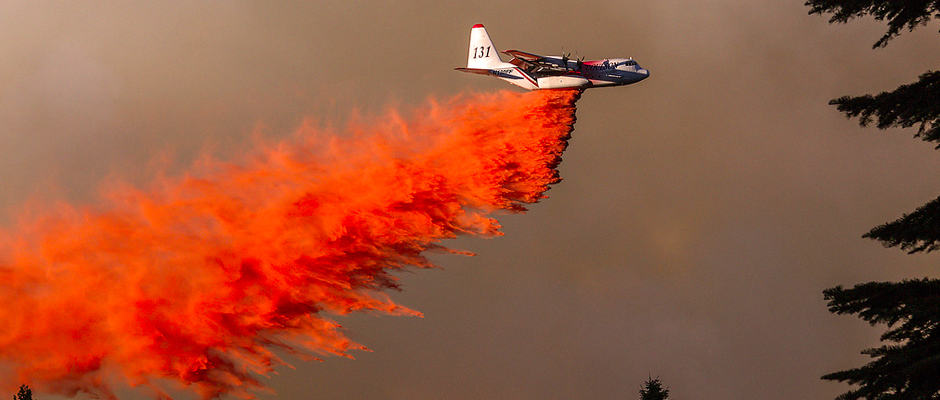Share this article
Fire Borrowing Negatively Impacts Wildlife Programs
One of the biggest funding shortfalls faced by any federal agency for the past several years has received a sharp uptick in legislative and media attention as a result of wildfires currently gripping the western U.S.
The issue at hand is fire borrowing, also known as fire transfer. Fire borrowing occurs when the cost for a federal agency to fight wildfires is larger than the amount of funds they have been allocated. The shortfall requires an agency to transfer funds from other program accounts to wildfire accounts.
In no other agency have these allocation shortfalls been more evident than in the U.S. Forest Service (USFS). This year alone, USFS will borrow $700 million dollars from other programs within the agency, marking the eighth time fire borrowing has occurred since 2002. While Congress has eventually paid many of these funds back to USFS in previous years, the short-term uncertainty caused by inadequate appropriations results in the delaying of non-wildfire projects and the freezing of non-wildfire accounts.
Funds are appropriated each year by Congress to fight wildfires based on the average cost of wildfires over the ten previous years. In 1995, wildfire management programs made up 16% of USFS appropriations. This year, the wildfire appropriations reached 52% of the agency’s total funding. According to a recently released USDA report on the rising cost of wildfire operations, in ten years 67% of the agency’s appropriated dollars will be spent on wildfire management operations if current trends continue and the funding model remains the same.
The ever-rising cost and frequency of wildfires has resulted in the ten-year average being unable to keep up with the financial reality of the situation. This has forced the practice of fire borrowing to be a budgetary drain to other USFS programs, including those used to manage wildlife and wildlife habitats.
Impacts to Wildlife
Wildlife and fisheries habitat management programs within USFS have suffered significantly as a result of funding shortfalls. Between FY2001 and FY2015, these programs have experiences an 18% reduction in appropriated funding from about $171 million to $140 million (adjusted for inflation). This reduced funding compounds the problems associated with fire borrowing.
Other programs have fared worse. The Deferred Maintenance and Infrastructure Improvement program, for example, has seen their appropriated budget nearly eliminated with a 95% reduction in budget in the same time frame.
The difference between programs such as deferred maintenance and wildlife and fisheries is that wildlife and fisheries habitat programs rely heavily on non-government funds. Non-government matching grants and partnerships allow USFS to implement further habitat management and conservation work. According to the previously mentioned USDA report, outside contributions can provide as much as a 4-to-1 return on what USFS invests into a project. The 18% reduction in funds has caused USFS to miss many opportunities to leverage external funds for wildlife and fisheries habitat management projects.
The drop in funding for wildlife-related USFS programs has corresponded with a bleak trend in wildlife and other non-wildfire job positions within USFS. Since 1998, USFS non-wildfire staff positions have decreased from around 18,000 to around 11,000. That same timeframe has seen over a two-fold increase in wildfire staff positions, from around 5,700 to more than 12,000.
Outlook
The disastrous wildfire season occurring in the West has left the issue of how to properly fund USFS consistently on the minds of Congress and Obama Administration. Two bills have been introduced with the goal of resolving the issue.
The first of these bills, titled the “Wildfire Disaster Funding Act” (S. 235, H.R.167), is similar to a provision in the President’s FY2016 budget proposal. Previously supported by TWS, this bill would allow USFS and the Department of the Interior (DOI) to utilize natural disaster funds if they spend 70% of their ten year average within a fiscal year. While the overwhelming majority of wildfires can be effectively managed, 1-2% of fires turn catastrophic and require about 30% the appropriated suppression budget. By allowing 30% of the cost of wildfires to be covered by natural disaster funds, the Wildfire Disaster Funding Act would identify catastrophic wildfires as natural disasters.
The second bill, titled the “Resilient Federal Forests Act” (H.R. 2647), would also provide natural disaster funding to fight wildfires, but only after USFS or DOI have spent 100% of their ten year average. In addition, this act aims to quicken habitat management and logging projects by streamlining National Environmental Policy Act reviews on projects that result in reduced wildfire risks and improvements in early successional habitats for wildlife. The bill also aims to hasten the rate of USFS projects by requiring groups that legally challenge the projects to post a bond to cover the government’s anticipated legal costs, which would be forfeited if they lose the case.
While the issue is seen as pressing, disagreement as to how to solve USFS’ funding woes has resulted in both pieces of legislation stalling. After passing the House, the Resilient Federal Forests Act has been stuck in the Senate Committee on Agriculture, Nutrition, and Forestry since July 13.
The Wildfire Disaster Funding Act has not fared much better. The House and Senate versions of the bill were introduced with broad bipartisan support, with 70 Democrat and 55 Republican cosponsors on the House side and 14 Democrat and 4 Republican cosponsors on the Senate side, but both bills have yet to receive a vote in either chamber.
Last year, the House failed to pass the Wildfire Disaster Funding Act. If Congress fails to fix USFS’ funding woes in years to come, non-wildfire suppression programs in USFS will continue to be financially drained, including those that make forests more resilient against fires in the long-term.
For information on how wildlife populations are impacted by wildfires, check out:
-The Wildlife Society’s Q&A: The Effect of Wildfires on California Wildlife
-USFS’ Fire Effects Information System, a collection of scientific literature reviews on the effects of fire to animal and plant populations
Additional Sources: Environment & Energy Daily (September 16, 2015), Greenwire (September 2, 2015) USDA Report-The Rising Cost of Wildfire Operations: Effects on the Forest Service’s Non-Fire Work (August 4, 2015), E&E News PM (July 8, 2015), Greenwire (October 30, 2013)
Header Image: Fire retardant being released during the 2014 King Fire in California
Image Credit: USFS Region 5, licensed by cc 2.0








